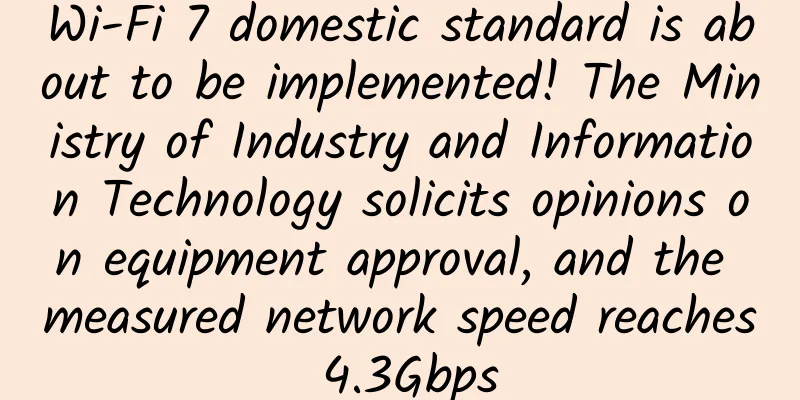Wi-Fi 7 domestic standard is about to be implemented! The Ministry of Industry and Information Technology solicits opinions on equipment approval, and the measured network speed reaches 4.3Gbps

|
On June 2, it was reported that the technical standard IEEE 802.11be (Wi-Fi 7), the next generation wireless LAN, has not yet been implemented in China. Once the relevant standards are officially implemented, a large number of products will be launched on the market. According to the Ministry of Industry and Information Technology's official website on June 1, Wi-Fi 7 standards are expected to be implemented soon. The government has officially released a public notice for comments on the "Notice of the State Radio Office on the Technical Requirements and Test Methods for the Approval of New Models of Wireless LAN Equipment Adopting the IEEE 802.11be Technical Standard (Draft for Comments)". The draft for comments points out that in order to guide the development of the wireless LAN industry, standardize the model approval of radio transmitting equipment of wireless LAN equipment (hereinafter referred to as model approval), and promote the compatibility and sharing of wireless LAN with 5G, Beidou, Internet of Vehicles and other services, it is proposed to add relevant technical requirements and testing methods for wireless LAN equipment that adopts the IEEE 802.11be technical standard in the model approval test. IT Home learned from the draft for comments that Wi-Fi 7 devices are expected to require testing of the multi-link operation (MLO) feature with an operating frequency range of 2400-2483.5MHz, 5150-5350MHz and 5725-5850MHz. Through chip-level multi-channel connections, throughput can be increased, making the network faster and avoiding freezes. The test of Wi-Fi 7 devices also introduced 4096-QAM, which increased the network transmission capacity from 10 bits to 12 bits per time, improving the throughput performance by about 20% compared to Wi-Fi 6. In fact, many mobile phones and routers have announced support for Wi-Fi 7 and used this as a selling point, such as the Xiaomi 13 series, which claims to take only 2.9 seconds to download a 1GB movie. In addition, Huawei conducted deployment tests on Wi-Fi 7 APs at the Network and Information Center of Southeast University in April, and the actual measured single-terminal rate of Wi-Fi 7 exceeded 4.3 Gbps. ▲ Image source: Huawei Data Communications Tests show that on Xiaomi 13 Pro, which supports the Wi-Fi 7 communication protocol standard |
<<: Seamless broadband experience: Unleashing the power of network services and infrastructure
Recommend
5G user development starts with focusing on high quality
[[385400]] Recently, the Ministry of Industry and...
What role can fiber optic technology play in education?
In the ever-evolving field of education, technolo...
TheStack Spring Promotion: KVM in 8 data centers including San Jose/Los Angeles/Phoenix starts at $10 per year
TheStack is an early established overseas server ...
Can 5G drive innovation in the smart home market?
[[348075]] We still have a long way to go before ...
Nginx log analysis: writing shell scripts for comprehensive log statistics
Nginx is a high-performance HTTP and reverse prox...
Seven key points! Understand the "Threat Information Blue Report" released by Weibu Online and China Academy of Information and Communications Technology
On December 3, 2021, the Security Research Instit...
Why 5G won’t replace Wi-Fi 6 at the edge anytime soon
[[419672]] The shift to hybrid work and widely di...
5G messaging is now available for trial use. Will it replace WeChat?
Will 5G messaging, known as a "killer" ...
HPE Aruba Networking: IT leaders lack awareness of how networking can enhance the employee experience
At present, the demand for hybrid office continue...
It will take time for 5G cross-network roaming to become popular
On May 17, at the opening ceremony of the "2...
Gartner: 5G network infrastructure revenue to grow by more than $5 billion in 2021
According to foreign media reports, Gartner's...
80VPS: Hong Kong/Korea/Japan VPS annual payment starts from 299 yuan, US cluster server 8*/27 total 232IP monthly payment starts from 750 yuan
80VPS has launched a mid-year promotion, offering...
Friendhosting's new Romania VPS starts from 2.99 euros per month, 25% off down payment
Friendhosting has sent out an email about a new n...
Huawei launches intelligent network to unleash the power of ultra-broadband with intelligence
[51CTO.com original article] Hangzhou, China, Oct...
HostUS: Los Angeles VPS starts at $16 per year, with 8 data centers available including Los Angeles
It has been more than a year since I shared infor...









